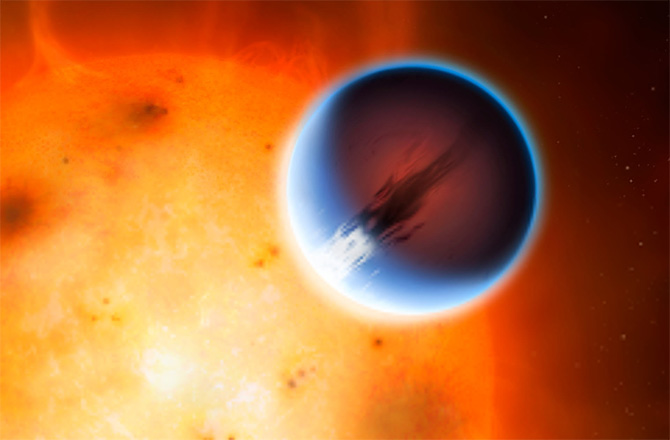Exoplanet's Global Winds Let Rip at 5,400 MPH

A windy day on HD 189733b is nothing to take lightly.
The planet, located about 63 light years away in the constellation Vulpecula, has winds reaching 5,400 mph, roughly 20 times faster than anything ever experienced on Earth.
PHOTOS: The Most Horrific Alien Planets In Our Galaxy
Granted, everything about HD 189733b is extreme. It's about 10 percent bigger than Jupiter, but its located 180 times closer to its parent star than Jupiter is to the sun, far closer than even Mercury, the innermost planet in the solar system.
Scientists estimate its temperature reaches almost 3,700 degrees Fahrenheit.
HD 189733b orbits its host start every 2.2 days, at a breakneck speed of 341,000 mph.
Scientists at the University of Warwick were able to measure velocities on the day and night sides of the planet. They discovered the 5,400 mph wind blowing from the day to the night side.
Get the Space.com Newsletter
Breaking space news, the latest updates on rocket launches, skywatching events and more!
ANALYSIS: Exoplanet Weather Forecast: Cloudy. Outlook: Cloudy
"As parts of HD 189733b's atmosphere move towards or away from the Earth the Doppler effect changes the wavelength of this feature, which allows the velocity to be measured," lead researcher Tom Louden said in a statement. "This is the first ever weather map from outside of our solar system."
Astronomers used HARPS, the High Accuracy Radial velocity Planet Searcher, in La Silla, Chile, to watch the planet as it passed in front of its host star, relative to the telescope's line of sight.
ANALYSIS: Exoplanet Weather Forecast: Hot and Nasty
"The surface of the star is brighter at the center than it is at the edge, so as the planet moves in front of the star the relative amount of light blocked by different parts of the atmosphere changes. For the first time we've used this information to measure the velocities on opposite sides of the planet independently, which gives us our velocity map," Louden said.
The research is being published in the Astrophysical Journal Letters.
This article was provided by Discovery News.
Join our Space Forums to keep talking space on the latest missions, night sky and more! And if you have a news tip, correction or comment, let us know at: community@space.com.

Irene Klotz is a founding member and long-time contributor to Space.com. She concurrently spent 25 years as a wire service reporter and freelance writer, specializing in space exploration, planetary science, astronomy and the search for life beyond Earth. A graduate of Northwestern University, Irene currently serves as Space Editor for Aviation Week & Space Technology.









